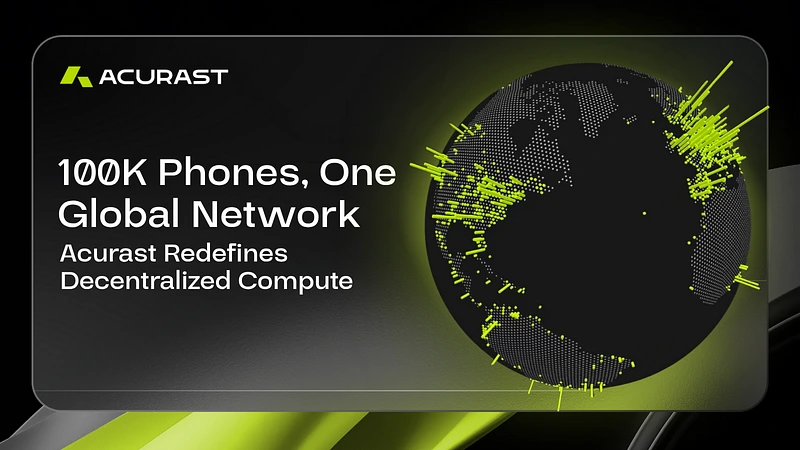Acurast is a decentralised physical infrastructure network (DePIN) designed to transform how cloud computing operates. Instead of relying on traditional data centres, Acurast taps into the unused processing power of smartphones worldwide, creating a secure, verifiable, and scalable compute network.
How Acurast Works
Acurast’s model is simple yet innovative. It uses the built-in security and processing power of smartphones to create a distributed compute system. This network allows developers to deploy and run applications without centralised infrastructure.
Key points:
- Smartphone-powered network: Uses Android and iOS devices as computing nodes.
- Security: Employs Trusted Execution Environments (TEEs) to ensure computations remain tamper-proof.
- Confidentiality: Protects sensitive data from both the network and device owners.
- Interoperability: Built using the Polkadot SDK, enabling cross-chain connections with Ethereum, Tezos, and other Web3 ecosystems.
Acurast Funding and Development
Acurast has recently secured $11 million in new funding, as reported by Acurast. This investment is set to drive the launch of its mainnet and the expansion of its smartphone-powered decentralised compute network.
The funding round includes a mix of grants and token-based contributions from notable investors across the blockchain and venture capital sectors. Participants in this latest round include:
- Dr. Gavin Wood, Co-founder of Ethereum and Founder of Polkadot
- Leonard Dörlochter, Founder of peaq
- Michael van de Poppe, Founder of MN Capital
- Scytale Digital and Sigma Capital
Acurast’s latest investment builds upon its strong early-stage performance, where it successfully completed an oversubscribed public token sale on CoinList in May 2025, raising $5.4 million. The company’s Genesis Mainnet is now confirmed to go live on 17 November 2025, marking a major step toward open, global compute infrastructure.
Founder Alessandro De Carli highlighted the milestone, noting that the mainnet will enable anyone to contribute or access decentralised compute resources securely and efficiently. With over 146,000 smartphones already onboarded and more than 489 million transactions processed, Acurast is moving rapidly toward establishing a scalable alternative to centralised cloud systems.
This latest funding marks a strong endorsement of Acurast’s mission to make computing more accessible, efficient, and user-driven through the power of existing mobile devices.
Leadership and Vision
Acurast is led by Alessandro De Carli, the Founder and driving force behind the project. His vision is to create a truly global and open compute fabric powered by billions of smartphones. The leadership team combines expertise in blockchain development, hardware security, and decentralised infrastructure to ensure both scalability and privacy.

Acurast Processor Types
Users can contribute to the Acurast network through two main processor modes:
- Processor Lite
- Uses regular smartphones.
- Runs the Acurast app in the background.
- Operates when the device is idle or charging.
- Processor Core
- Requires a dedicated device.
- Offers higher performance and security.
- Ideal for long-term and critical workloads.
This flexibility allows anyone to join the network, from casual users to enterprise-level contributors.
Benefits of Acurast
Acurast’s decentralised architecture offers multiple benefits for both users and developers:
- Energy efficiency: Uses existing devices instead of new servers.
- Scalability: Expands easily as more devices join.
- Reduced costs: Eliminates dependency on costly data centres.
- Privacy-focused: Computations are secure, even from device owners.
- Incentives: Users earn rewards by sharing compute power.
The ACU Token and Its Role
The native ACU token underpins Acurast’s ecosystem. It is used for:
- Network fees: Required to perform transactions within the network.
- Staking: Providers stake ACU as collateral to maintain reliability.
- Rewards: Earned by participants contributing computing power.
- Governance: Enables token holders to influence network decisions.
How to Get Involved
Joining Acurast is straightforward. Individuals can download the Acurast Processor app, available in Lite or Core versions, and begin contributing compute power. By staking ACU tokens, participants earn rewards for their contributions while supporting the reliability of the network.
Developers can deploy their applications using the Acurast Hub, accessing decentralised computation for a wide variety of use cases. Community members can join programs like Cloud Rebellion, which reward participation and help expand the network’s footprint.
Industry Context
Acurast’s approach positions it as a strong alternative to conventional cloud systems like Amazon Web Services or Google Cloud. By removing centralised control, it offers resilience and cost advantages, particularly for Web3 developers.
This initiative aligns with the UK government’s increasing interest in digital infrastructure and decentralised technology. You can read more about current innovation policies on the UK Government website.
Related Resources
To explore related content and topics, visit:
- Aily Labs Raises $80 Million: How This AI Decision Platform Is Transforming Fortune 500 Operations
- Stonal: AI-Powered Data Management Transforming Real Estate
- Upside VC: The Sidemen’s $25 Million Creator-Backed Venture Capital Fund Redefining Consumer Investment
- Lauxera Capital Partners: Powering Global Growth in Healthtech Innovation

